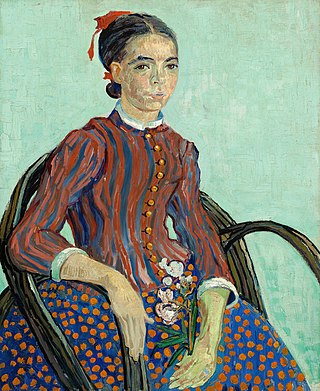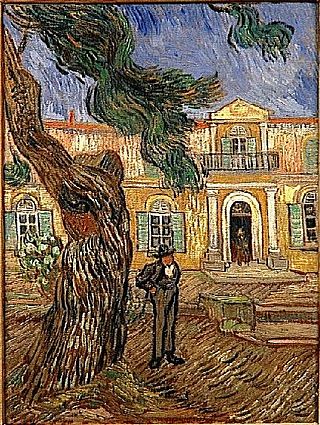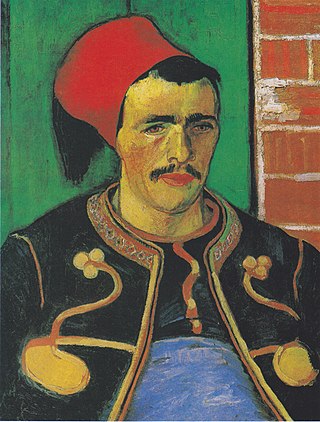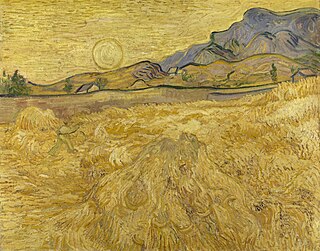
Vincent Willem van Gogh was a Dutch Post-Impressionist painter who is among the most famous and influential figures in the history of Western art. In just over a decade, he created approximately 2100 artworks, including around 860 oil paintings, most of them in the last two years of his life. His oeuvre includes landscapes, still lifes, portraits, and self-portraits, most of which are characterized by bold colors and dramatic brushwork that contributed to the rise of expressionism in modern art. Van Gogh's work was beginning to gain critical attention before he died at age 37, by what was suspected at the time to be a suicide. During his lifetime, only one of Van Gogh's paintings, The Red Vineyard, was sold.
The year 1890 in art involved some significant events.

The Starry Night is an oil-on-canvas painting by the Dutch Post-Impressionist painter Vincent van Gogh painted in June 1889. It depicts the view from the east-facing window of his asylum room at Saint-Rémy-de-Provence, just before sunrise, with the addition of an imaginary village. It has been in the permanent collection of the Museum of Modern Art in New York City since 1941, acquired through the Lillie P. Bliss Bequest. Widely regarded as Van Gogh's magnum opus, The Starry Night is one of the most recognizable paintings in Western art.

Fall of Leaves , or Falling Autumn Leaves is a pair of paintings by the Dutch painter Vincent van Gogh. They were executed during the two months at the end of 1888 that his artist friend Paul Gauguin spent with him at The Yellow House in Arles, France.
Vincent van Gogh lived during the Impressionist era. With the development of photography, painters and artists turned to conveying the feeling and ideas behind people, places, and things rather than trying to imitate their physical forms. Impressionist artists did this by emphasizing certain hues, using vigorous brushstrokes, and paying attention to highlighting. Vincent van Gogh implemented this ideology to pursue his goal of depicting his own feelings toward and involvement with his subjects. Van Gogh's portraiture focuses on color and brushstrokes to demonstrate their inner qualities and Van Gogh's own relationship with them.
Vincent Van Gogh was displayed at the 1890 Les XX exhibition—an invitation-only show exclusively for members—in Brussels, Belgium. This served to demonstrate the recognition Van Gogh received from his avant-garde peers during his life. The choices of his works and their arrangements illustrated his thinking about his years of work in Provence.

The Wheat Field is a series of oil paintings executed by Vincent van Gogh in Saint-Rémy-de-Provence. All of them depict the view Van Gogh had from the window of his bedroom on the top floor of the asylum: a field enclosed by stone walls just beneath his window and excluded from normal life by the rear wall of the asylum grounds; beyond this enclosure farm land, accompanied by olive groves and vineyards, ran up to the hills at the foot of the mountain range called Les Alpilles.

The Langlois Bridge at Arles is the subject of four oil paintings, one watercolor and four drawings by Vincent van Gogh. The works, made in 1888 when van Gogh lived in Arles, in southern France, represent a melding of formal and creative aspects. Van Gogh used a perspective frame that he built and used in The Hague to create precise lines and angles when portraying perspective.

Landscape with Snow is a painting by Vincent van Gogh in 1888, believed to be one of the first paintings that he made in Arles. It is one of at least ten 1882 to 1889 oil and watercolor van Gogh paintings of a snowy landscape. The painting reflects the La Crau plains set against Montmajour and hills along the horizon.

La Mousmé also known as La Mousmé, Sitting in a Cane Chair, Half-Figure was painted by Vincent van Gogh in 1888 while living in Arles, which van Gogh dubbed "the Japan of the south". Retreating from the city, he hoped that his time in Arles would evoke in his work the simple, yet dramatic expression of Japanese art.

Farmhouse in Provence, also known as Entrance Gate to a Farm with Haystacks, is an oil-on-canvas painting produced in 1888 by Dutch painter Vincent van Gogh in Arles, Provence, at the height of his career. Partially due to having been inspired by painter Adolphe Monticelli, Van Gogh sought the Provence region of France to further expand his painting skill and experience. Van Gogh used several pairs of complementary colors in the Farmhouse in Provence, the color contrast bringing an intensity to his work. The painting is owned by the National Gallery of Art in Washington, D.C.

Wheat Fields is a series of dozens of paintings by Dutch Post-Impressionist artist Vincent van Gogh, borne out of his religious studies and sermons, connection to nature, appreciation of manual laborers and desire to provide a means of offering comfort to others. The wheat field works demonstrate his progression as an artist from the drab Wheat Sheaves made in 1885 in the Netherlands to the colorful and dramatic 1888–1890 paintings from Arles, Saint-Rémy and Auvers-sur-Oise in rural France.

Vincent van Gogh enjoyed making Paintings of Children. He once said that it's the only thing that "excites me to the depths of my soul, and which makes me feel the infinite more than anything else." Painting children, in particular represented rebirth and the infinite. Over his career Van Gogh did not make many paintings of children, but those he completed were special to him. During the ten years of Van Gogh's career as a painter, from 1881 to 1890, his work changed and grew richer, particularly in how he used color and techniques symbolically or evocatively.

Almond Blossoms is a group of several paintings made in 1888 and 1890 by Vincent van Gogh in Arles and Saint-Rémy, southern France of blossoming almond trees. Flowering trees were special to van Gogh. They represented awakening and hope. He enjoyed them aesthetically and found joy in painting flowering trees. The works reflect the influence of Impressionism, Divisionism, and Japanese woodcuts. Almond Blossom was made to celebrate the birth of his nephew and namesake, son of his brother Theo and sister-in-law Jo.

Saint-Paul Asylum, Saint-Rémy is a collection of paintings that Vincent van Gogh made when he was a self-admitted patient at the Saint-Paul asylum in Saint-Rémy-de-Provence, since renamed the Clinique Van Gogh, from May 1889 until May 1890. During much of his stay there he was confined to the grounds of the asylum, and he made paintings of the garden, the enclosed wheat field that he could see outside his room and a few portraits of individuals at the asylum. During his stay at Saint-Paul asylum, Van Gogh experienced periods of illness when he could not paint. When he was able to resume, painting provided solace and meaning for him. Nature seemed especially meaningful to him, trees, the landscape, even caterpillars as representative of the opportunity for transformation and budding flowers symbolizing the cycle of life. One of the more recognizable works of this period is The Irises. Works of the interior of the hospital convey the isolation and sadness that he felt. From the window of his cell he saw an enclosed wheat field, the subject of many paintings made from his room. He was able to make but a few portraits while at Saint-Paul.

The Zouave is the subject of several sketches and paintings made by Vincent van Gogh in Arles, France in June 1888. The pieces range from close up oil painting portraits of the Zouave to full-body drawings. Van Gogh produced this collection of pieces during the period he spent in southern France, which many scholars regard as the zenith of his artistic career.Van Gogh nonetheless expressed frustration about his work during this time.

Peasant Character Studies is a series of works that Vincent van Gogh made between 1881 and 1885.

Enclosed Field with Peasant is an oil painting by Dutch artist Vincent van Gogh, painted around 12 October 1889. The Size 30 painting, measuring 73 cm × 92 cm, depicts a scene of a ploughed field near the asylum at Saint-Rémy-de-Provence, with a lilac bush, a peasant carrying a wheatsheaf, several buildings, and the Alpilles mountains rising behind, with a small patch of sky. Van Gogh considered it a pendant painting to The Reaper executed earlier in 1889. It is currently part of the permanent collection at the Indianapolis Museum of Art.

Reaper, Wheat Field with Reaper, or Wheat Field with Reaper and Sun is the title given to each of a series of three oil-on-canvas paintings by Vincent van Gogh of a man reaping a wheat field under a bright early-morning sun. To the artist, the reaper represented death and "humanity would be the wheat being reaped". However, Van Gogh did not consider the work to be sad but "almost smiling" and taking "place in broad daylight with a sun that floods everything with a light of fine gold".
















